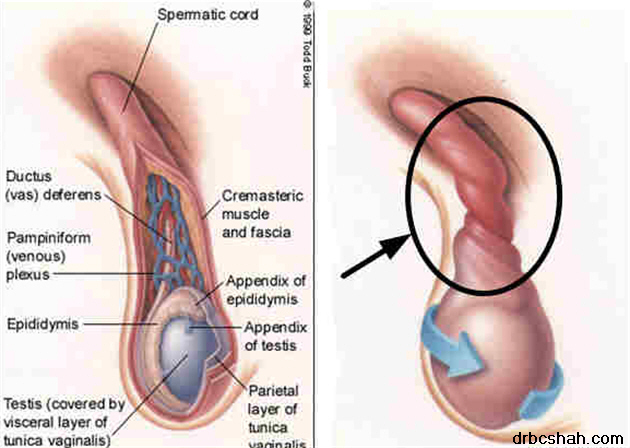Testicle Fixation
What is it?
From what you tell us and from what we have found, it looks as if your child’s testis is twisting round (undergoing torsion). The twisting nips the artery and veins (the pipes that give and drain blood respectively) of the testis and slows down or stops completely the blood flow to it. This gives pain and swelling of the testis.
The testis may die if it is not operated on. In fact, the whole testis may not be twisted, just a small tag on the testis can give the same picture.
Sometimes infection around the testis mimics a twist or torsion. However it is safer for your child to have an operation than to risk loss of the testis.
The operation
Your child will have a general anaesthetic, and will be asleep for the whole operation.
After your child goes to sleep with the anaesthetic, a cut is made in the scrotum. Dr. B C Shah has a look at the testis through the opening. If it is twisted, he untwists it. He fixes it with stitches under the skin so that it cannot twist again. He does the same to the other testis, so that this one will not twist at a later date.
If the testis is already dead, it is best to take it out and it will be sent to the laboratory to be examined under a microscope. The other testis should be enough for all your son’s needs in the future. If Dr. B C Shah finds something else instead, he will deal with that as needed. He will let you know the result of examination and the test.
Usually you can take your child home one or two days after the operation.
Any alternatives?
If you leave things as they are, the testis is very likely to die. The same can happen to the other side, leading to serious hormone problems.
Special ultrasound tests can be helpful, but an operation is the only way of being certain. Massaging and trying to untwist the testis through the skin rarely works and can offer some comfort but there is a very high chance that the testis will twist again soon. Therefore, an operation is the only reliable and definitive solution.
Before the operation
Your son will be welcomed to the ward by the nurses or the receptionist. He will have his hospital details checked. He will be put to bed in a gown. He will have some basic tests done to make sure that he is well prepared and that he can have the operation as safely as possible.
You will be asked to hand in any medicines or drugs he may be taking so that his drug treatment in hospital will be correct. Please tell Dr. B C Shah of any allergies to drugs or dressings.
Your son will be seen by Dr. B C Shah who will examine him. You and your child will have the operation explained to you and you will be asked to fill in an operation consent form.
Before you sign the consent form giving permission for the operation to go ahead, make sure that you fully understand all the information that was given to you regarding your child’s health, the possible and proposed treatments and any potential risks. Feel free to ask more questions if things are not entirely clear.
The operation site will be marked with a skin pencil. Your son will be seen by Dr. B C Shah who will be doing the operation. He will check that all the necessary preparations have been made.
After – in hospital
Your child will be sleepy after the operation and is likely to sleep for an hour or more afterwards.
The drugs given for a general anaesthetic will make your child clumsy, slow and forgetful for about 24 hours. This happens even if your child feels quite all right. The nurses will support you to help him with everything he needs until he feels better.
Your child will probably not notice any significant pains. If necessary he can take a painkiller by mouth, such as paracetamol in a liquid form. By the end of one week the wound should be virtually pain-free.
Your child will be able to drink again two to three hours after the operation. He should be able to eat normally the next day. There will be dissolvable stitches in the skin. They slip out after 7 to 10 days.
The wound will have a cellulose dressing rather like nail varnish. There may be some swelling of the surrounding skin which improves in two to three days. This can happen and you and your child should not worry about it.
After 7 to 10 days, slight crusts on the wound will fall off. The cellulose varnish will peel off. Occasionally minor matchhead sized blebs (blisters) form on the wound line. These settle down after discharging a blob of yellow fluid for a day or so.
If stitches are still there after 10 days, phone Dr. B C Shah because they may have to be removed. Do not try to remove them yourself.
Your child can wash but try to keep the wound area dry until the stitches are out. Baths or showers with ordinary soap and water are all right. Salted water is not necessary.
You will be given an appointment to bring your child to the outpatient department, after leaving hospital for a check up.
Some hospitals arrange a check-up about one month after leaving hospital. By this time, the results of the laboratory examination of the removed testis (if this was the case) will be ready. Others leave check-ups to the general practitioner.
After – at home
Your child may need frequent sleeps for a day or two. Although it is usually difficult to limit what he does, try to help your child avoid any excess physical activity for four to six weeks after the operation.
You need to make sure that he is careful and doesn’t aggravate the wound. This can be very painful, cause bleeding and, sometimes, an infection.
If your child goes to school he can return to lessons after about 10 days. He can restart any sport after about four to six weeks.
Possible complications
As with any operation under general anaesthetic, there is a very small risk of complications related to the heart and the lungs.
If the testis is twisted and very painful, the risk from the anaesthetic is slightly higher when the operation is done as an emergency. The tests that your child will have before the operation will make sure that he can have the operation in the safest possible way and will bring the risk for such complications very close to zero.
If you think that all is not well, please let Dr. B C Shah know. There is often some swelling and even some redness around the wound. These usually settle in three or four days.
Bleeding is very rarely a problem and is usually stopped with some extra pressure on the wound area. Extremely rarely, another operation is needed to stop the bleeding. Infection in the wound area is a rare problem and settles down with antibiotics in a week or two.
There is also a chance that your child can experience some swelling of the testis. This also gets settled by taking antibiotics for a week or two.
There is a chance that the testis will stay alive after the operation but will have some shrinkage (atrophy). This can happen because the blood supply to the testis was affected for a long time while it was twisted or because after the operation the blood flow did not return to normal.
If the testis in fact dies despite the operation, the wound will get quite painful and swollen. Phone Dr. B C Shah for advice if you are in doubt. This situation will require prompt medical attention and another operation might be needed to deal with the problem.
Another rare complication that can happen during this operation is damage to the structures that carry the sperm from the testis. This can have an affect on your child’s fertility in the future (his ability to father children) since one of his testes will not contribute sperm. You should discuss the possibility of this rare complication with Dr. B C shah.
General advice
The operation to untwist, fix and save the testis is successful in 80 to 100 per cent of cases if it is done within four to six hours from the moment the problem started and your child developed pain.
If the operation takes place six to eight hours after the initiation of the problem the chances of success are dramatically smaller and after 12 hours are diminished. Therefore, in the future, it is important to know that if you have even the slightest suspicion that one of your children develops a similar problem, it is vital to come to the hospital urgently.
These notes will help you and your son through your child’s operation. They are a general guide. They do not cover everything. Also, all hospitals and surgeons vary a little.
If you have any queries or problems, please ask Dr.B C Shah.


 Dr. Bimal Shah is the senior most General & Laparoscopic surgeon in Mira – Bhayandar with largest series of operations. He also consults at Borivali – Dahisar. He believes in ethical practice & is available at only trust hospitals. He passed out from KEM hospital, Mumbai in 1993 and was a lecturer training newer surgeons & medical students till 1998.
Dr. Bimal Shah is the senior most General & Laparoscopic surgeon in Mira – Bhayandar with largest series of operations. He also consults at Borivali – Dahisar. He believes in ethical practice & is available at only trust hospitals. He passed out from KEM hospital, Mumbai in 1993 and was a lecturer training newer surgeons & medical students till 1998. 






